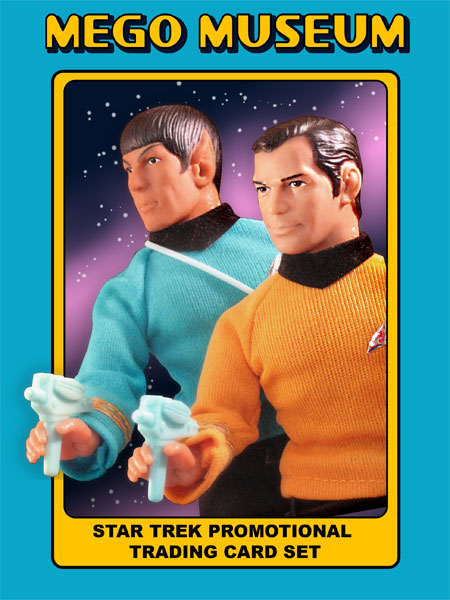 Mego’s “Star Trek” line was “officially” based on the live-action series in syndication in 1974, but the Mego designers appear to have referred repeatedly to The Animated Series for inspiration. It’s not difficult to imagine why frugal, economical Mego would choose a property like “Star Trek” to exploit as part of the company’s eight-inch action figure line. Since most of the crew wore the same basic uniform–and used the same weapons and equipment–Mego anticipated minimum design cost combined with maximum utilization potential–a win-win situation if ever one existed. In fact, so high was Mego’s confidence in the line that they took the unprecedented step of creating specific lower-leg tooling for the male crew members. The Starfleet-issued boots were incorporated into the figure itself, saving countless lost pairs of Mego footwear at the hands of careless children–as well as eliminating one more step in the assembly process.
Mego’s “Star Trek” line was “officially” based on the live-action series in syndication in 1974, but the Mego designers appear to have referred repeatedly to The Animated Series for inspiration. It’s not difficult to imagine why frugal, economical Mego would choose a property like “Star Trek” to exploit as part of the company’s eight-inch action figure line. Since most of the crew wore the same basic uniform–and used the same weapons and equipment–Mego anticipated minimum design cost combined with maximum utilization potential–a win-win situation if ever one existed. In fact, so high was Mego’s confidence in the line that they took the unprecedented step of creating specific lower-leg tooling for the male crew members. The Starfleet-issued boots were incorporated into the figure itself, saving countless lost pairs of Mego footwear at the hands of careless children–as well as eliminating one more step in the assembly process.
Additionally, Mego had impeccable timing when it came to picking up the “Star Trek” license. With a pittance of an investment, they bought into a virtually dead property that was in the throes of rebirth and rediscovery by a whole new legion of fans–fans clamoring for anything with the words “Star Trek” on it.
The original five “Star Trek” figures were released in 1974, and included Capt. Kirk, Mr. Spock, Dr. McCoy (Bones), Mr. Scott (Scottie), and the Klingon. It is notable that these were the first 8″ Mego figures to be available exclusively on blister cards, having never been available in boxes throughout the entirety of their run. The initial card art featured profile paintings of all five characters, the “Star Trek” logo in white, and each figure’s name depicted in white text above the bubble. The package back also featured these same five profiles on a blue field. These cards were later amended to include Lt. Uhura as the late, feminist-conscious addition to the first series. Her profile was added to the line-up, and the “Star Trek” logo was changed to a more colorful light blue. Additionally, the back was replaced with advertisements for the U.S.S. Enterprise Playset and Communicator walkie-talkies over a field of purple. A later amendment to the first series cards consisted of changing the text of the figure’s name from white to the color of the respective character’s profile circle. The first series was originally released on Type 1 bodies with several running changes in the facial paint schemes. These were soon transitioned to Type 2 bodies, where the manufacturing settled down to a more uniform process. As a rule-of-thumb, Type 1 bodies are found on “5-face” cards, while Type 2 bodies are found on “6-face” cards. There have been “transitional” specimens found which do not conform to this distribution pattern, but they are quite uncommon. All six figures were available individually through popular mail-order venues of 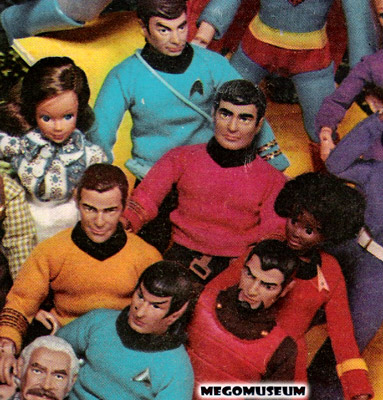 the day (Sears, Montgomery Ward’s, etc.). These mail-order figures each came in a clear plastic bag, which in turn was shipped in a small, non-descript brown carton. Although not especially attractive or collectible, mailer boxes were far less prevalent than standard retail packaging, and, due in no small part to their underwhelming appearance, were most often discarded upon receipt. Assembling a set of these figures in catalog packaging can be a daunting task; luckily, few collectors care enough to accept the challenge. Additionally, the original five figures (sans Uhura) were included in an exceptionally-rare U.S.S. Enterprise Gift Set. These figures came individually-packaged in baggies identical to their catalog brethren. Type 1 figures were definitely included in the gift set; however, it cannot be confirmed whether the Enterprise saw a long-enough production lifespan which would have allowed the possibility of Type 2 inclusion.
the day (Sears, Montgomery Ward’s, etc.). These mail-order figures each came in a clear plastic bag, which in turn was shipped in a small, non-descript brown carton. Although not especially attractive or collectible, mailer boxes were far less prevalent than standard retail packaging, and, due in no small part to their underwhelming appearance, were most often discarded upon receipt. Assembling a set of these figures in catalog packaging can be a daunting task; luckily, few collectors care enough to accept the challenge. Additionally, the original five figures (sans Uhura) were included in an exceptionally-rare U.S.S. Enterprise Gift Set. These figures came individually-packaged in baggies identical to their catalog brethren. Type 1 figures were definitely included in the gift set; however, it cannot be confirmed whether the Enterprise saw a long-enough production lifespan which would have allowed the possibility of Type 2 inclusion.
Kirk, Spock, McCoy, and the Klingon were re-released in 1979 for Sears, presumably to provide supplemental product for Star Trek: The Motion Picture, as well as to clear out excess stock in Mego’s warehouse. These reissues differ from the originals in three fundamental respects: first, they were assigned new assortment and item numbers; second (and most famously), in an excessive demonstration of economy, they were released without printing on the package back (earning them the nickname of “Blank-Backs”); and third, the majority of the reissues were given (once the backstock of traditional, two-part “stick-on” foil insignias had been depleted) what appear to be heat-sealed foil insignias, easily differentiated by their white edges.
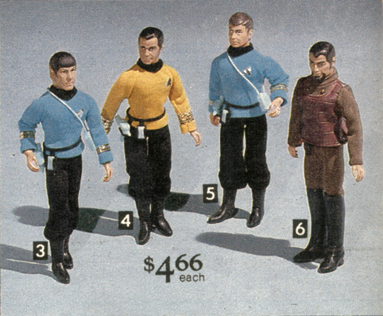
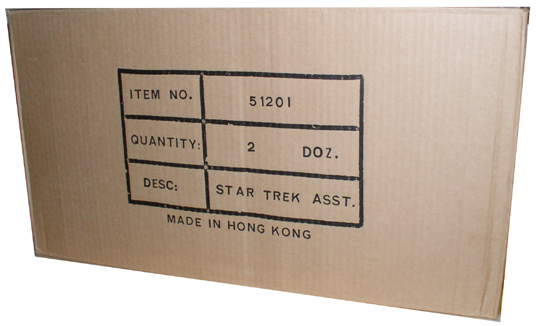 As popular and collectible as the “Star Trek” crew figures are/were, a sizable warehouse discovery of these gems was unearthed in Canada in the mid-1980s, leading to a drop-off in value that the collecting community is only now beginning to recover from, some twenty years later. This reduction in perceived value is both a blessing and a curse, however. While the drop in monetary value has hurt many a speculator and investor in the short-term, the overall affordability and availability of these figures has made them a perennial favorite of collectors–both Star Trek and Mego alike–and a staple of even the most basic Mego collection.
As popular and collectible as the “Star Trek” crew figures are/were, a sizable warehouse discovery of these gems was unearthed in Canada in the mid-1980s, leading to a drop-off in value that the collecting community is only now beginning to recover from, some twenty years later. This reduction in perceived value is both a blessing and a curse, however. While the drop in monetary value has hurt many a speculator and investor in the short-term, the overall affordability and availability of these figures has made them a perennial favorite of collectors–both Star Trek and Mego alike–and a staple of even the most basic Mego collection.
The outstanding success of the “Star Trek” line naturally led to new releases over the next two years. Mego’s first priority was to give the Enterprise crew more adversaries to fight. In 1975, four new figures were released: a Neptunian, the Keeper, a Gorn, and a Cheron. These characters were released under the new general heading of “Aliens.” It is probably more accurate to describe these Aliens as “inspired by” rather than “from” the “Star Trek” series. Mego was a pioneer in the field of licensing popular intellectual property for toy manufacture, and the problem with being a trailblazer is that there is no one ahead of you to set the standard. Mego was making it up as they went, and Paramount, being just as inexperienced in licensing (and still not fully grasping the cultural phenomenon that “Star Trek” was becoming), wasn’t very concerned with cracking the whip of consistency. As a result of this relaxed attitude to canonical adherence, the majority of the figures in the Aliens series can best be described as having merely a passing resemblance to their namesakes. In several instances, the Alien figures bear more of a resemblance to The Animated Series designs than the The Original Series; this is presumably due to the fact that The Animated Series was currently broadcasting at the time Mego’s “Star Trek” line was in development. These first Aliens are several orders of magnitude rarer than any of the crew or the Klingon, but common enough to carry fairly reasonable price tags, allowing even the most casual Mego collector to obtain them. These figures stayed in production throughout the final series, which helps to explain the relative ease in acquiring them. The figures released from this point on were all Type 2 bodies. Due to the exotic nature of alien characters, most of the bodies used for the figures were of strange and unique colors, were of an abnormal size, or had unique, character-specific body components created for them. These were all nice touches, to be sure, but they do not make the task of repairing figures any easier for the loose Mego collector. Mego also created new card art for the Aliens series, a striking planetary vista with steep mountains rising to the left, and a red planet and blue moon hung against a black, starry night. The back of the package featured new profile paintings of the ten figures available at that point, as well as ads for the Enterprise Playset, Tricorder, Tribble (whose existence is still debated to this day), Mission to Gamma VI Playset, Phaser Battle Game, Phaser Gun Game, Command Communications Console, and Communicators. The card art for the UK Palitoy releases was even more impressive and bold, with profiles of the Aliens on the front, and a card back design very reminiscent of the original “5-face” card back.
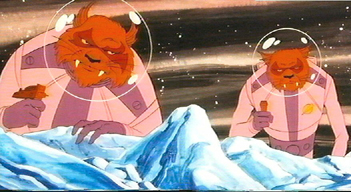 In spite of many glaring inaccuracies and inconsistencies with the established “Star Trek” canon, these four Aliens sold well-enough to warrant a third (and, as it would turn out, final) series of “Trek” figures, consisting of four more Aliens: a Romulan, a Talosian, an Andorian, and a Mugato. These four figures are counted among the rarest of Mego’s produced figures, for decades this was believed to due to a warehouse fire, however, this is 100% false and the true reason these figures prove harder find is due to their limited production run. The fire myth is used in this instance is a testament to the stature of these four figures and the fascination that surrounds their manufacture and relative scarcity; when you talk about series three, you’re not so much relating history as you are delving into action figure folklore. These final Aliens rank up there with Alter Egos, Teen Titans, and Space: 1999, a fact borne out by the prices they consistently command. Regardless of any warehouse disasters, this series of figures would still have been in high demand today if only for two reasons: the Romulan and the Andorian, two Aliens whose canonical accuracy and innate style almost make up for the glaring deficiencies present in the other six. Mego, for reasons unknown, created new card art for these figures as well. Actually, “recreated” is probably a more apt term, since they closely patterned the new design on the previous one, making only slight changes. The new card art still depicted essentially the same planetary landscape, but it differed in several important respects: firstly, the “sky” was changed from black to blue; secondly, the stars were all-but-removed; thirdly, the card maintained the width of the previous card design, but was now noticeably taller; and fourthly, the card back now featured all fourteen of the “Star Trek” figures, while simultaneously eliminating half of the accessories advertised on the previous package to make room for the profile expansion. In addition to releasing the final four Aliens on these new cards, Mego took the trouble to re-release the previous series of Aliens on the new card art as well. This fact could be attributed to a desire for uniformity on Mego’s part, if it were not so painfully obvious from almost all other evidence that uniformity was pretty low on Mego’s list of priorities. The eight-inch line of “Star Trek” figures effectively died with these last four Aliens; so, too, did every Trekkie’s dreams of a Harry Mudd or a Khan, a Sulu or a Chekov, a Nurse Chapel or a Yeoman Rand. It would be left to the Mego customizers, a generation later, to pick up the ball that Mego dropped in 1976.
In spite of many glaring inaccuracies and inconsistencies with the established “Star Trek” canon, these four Aliens sold well-enough to warrant a third (and, as it would turn out, final) series of “Trek” figures, consisting of four more Aliens: a Romulan, a Talosian, an Andorian, and a Mugato. These four figures are counted among the rarest of Mego’s produced figures, for decades this was believed to due to a warehouse fire, however, this is 100% false and the true reason these figures prove harder find is due to their limited production run. The fire myth is used in this instance is a testament to the stature of these four figures and the fascination that surrounds their manufacture and relative scarcity; when you talk about series three, you’re not so much relating history as you are delving into action figure folklore. These final Aliens rank up there with Alter Egos, Teen Titans, and Space: 1999, a fact borne out by the prices they consistently command. Regardless of any warehouse disasters, this series of figures would still have been in high demand today if only for two reasons: the Romulan and the Andorian, two Aliens whose canonical accuracy and innate style almost make up for the glaring deficiencies present in the other six. Mego, for reasons unknown, created new card art for these figures as well. Actually, “recreated” is probably a more apt term, since they closely patterned the new design on the previous one, making only slight changes. The new card art still depicted essentially the same planetary landscape, but it differed in several important respects: firstly, the “sky” was changed from black to blue; secondly, the stars were all-but-removed; thirdly, the card maintained the width of the previous card design, but was now noticeably taller; and fourthly, the card back now featured all fourteen of the “Star Trek” figures, while simultaneously eliminating half of the accessories advertised on the previous package to make room for the profile expansion. In addition to releasing the final four Aliens on these new cards, Mego took the trouble to re-release the previous series of Aliens on the new card art as well. This fact could be attributed to a desire for uniformity on Mego’s part, if it were not so painfully obvious from almost all other evidence that uniformity was pretty low on Mego’s list of priorities. The eight-inch line of “Star Trek” figures effectively died with these last four Aliens; so, too, did every Trekkie’s dreams of a Harry Mudd or a Khan, a Sulu or a Chekov, a Nurse Chapel or a Yeoman Rand. It would be left to the Mego customizers, a generation later, to pick up the ball that Mego dropped in 1976.
Mego had experienced tremendous success in the marketing of same-scaled vehicles and environments for their World’ Greatest Super-Heroes line and their Planet of the Apes series. Almost immediately, “Trek” proved itself a runaway hit on the toy aisle. In quick order, Mego decided to provide ancillary products for the “Star Trek” figures, in much the same vein as those afforded to the WGSH and Apes. “Trek” proved a unique challenge, however. Mego was used to designing cars, helicopters, motorcycles, vinyl playsets and the like in the eight-inch scale which they pioneered. The first question the designers inevitably asked was this: “How do you make a Starship in the eight-inch scale?” Mego’s solution to this issue was inspired, and, in many ways, simply couldn’t be done today, with the current generation brought up on the prerequisite of ultra-realism in their toys. Forgoing accuracy and instead focusing on play-value and bright, eye-catching colors, Mego unveiled the U.S.S. Enterprise Playset in 1975. It was a tremendous success, as evidenced by the vast number of Enterprise Playsets that still turn up today; it seems that every boy in the mid-‘Seventies had one of these playsets. This playcase is laughable by today’s toy craftsmanship standards, but its charm and innocence are hard to ignore. Mego focused on the bridge of the Enterprise for its layout, but included a wing on each side of the playset devoted to two more key areas of the Enterprise. On the right was a small room that was, at least ostensibly, the Engine Room (really nothing but a non-descript corner in which to stick your Scottie figure), and on the left was the real star of the toy, the Transporter Room. The Transporter mechanism was an engineering feat even Scottie would be proud of. To simulate the effect of “beaming,” you would put a figure in one side of a vertical tumbler, and spin the knob. Brightly-colored labels would flash by as the cylinder spun, giving a rather art-deco interpretation to the act of Transporting. By pressing one of two buttons on the top of the playset, you could stop the mechanism–on a dime!–in either the “beamed in” or “beamed out” position. A secret door, not unlike those found on the cabinets of shifty illusionists, was present at the rear of the mechanism, allowing the child to remove the figure without the rest of the crew noticing! Sneaky…
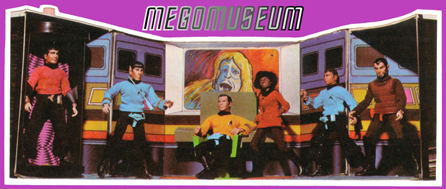
The Enterprise Playset, and its Transporter component, proved so popular that both the United Kingdom and the United States received one additional derivative playset each. The UK “Trek” fans were treated to a stand-alone Transporter Room toy, released by Mego’s British associate, Palitoy-Bradgate, in lieu of an actual Enterpise Playet. Alternatively, Mego buyers in America got, judging by the few specimens that exist, an extremely-limited Enterprise Gift Set which included the original five figures (Uhura being the odd woman out) on Type 1 bodies. Little is known for certain about this Gift Set, aside from the fact that it exists. Rumours abound that it was a Canadian exclusive, but this is unlikely, as Canada, along with France, got a smaller Enterprise Playset (about 10% smaller) for distribution, along with a smaller, bi-lingual box. It is doubtful that two Enterprises of conflicting sizes were released in the same country. Now that kids had the Enterprise, they needed somewhere to take it for an outer-space adventure. Enter the Mission to Gamma VI Playset, a toy very loosely based on the “Trek” episode, “The Apple.” The Gamma VI Playset came with a terribly fragile plant-trap, four tiny aliens that were way out of scale with the eight-inch “Trek” figures and which were easily lost, a plastic alien throne and idol facade which drew attention away from the cardboard-construction comprising the rest of the set, and a glove monster prone to rips and tears. This playset was not widely-released to begin with; when you couple this fact with its extreme fragility and ease of piece-loss, you begin to understand the sky-high prices that this playset regularly demands. A final eight-inch accessory was released, the Telescreen Console. This toy is notable for being the only eight-inch accessory to require batteries. The Telescreen Console was Mego’s answer to home video games in a pre-home-video-game world. A screen, sitting in front of a captain’s chair, was used to display enemy targets which could be fired upon electronically. This accessory is pretty unremarkable and primitive, and has limited long-term play value. It’s the kind of toy that a six-year old will beg his mother for, only to tire of it after ten minutes of play. Really, the only thing that qualifies this toy as an eight-inch accessory is the presence of the captain’s chair; other than that detail, this toy could easily be lumped into the role-playing category of Mego’s “Trek” offerings. The Telescreen is rare, but it is also a rather underwhelming accessory–certainly the weakest of the five–so there are few collectors out there actively hunting one. Mego made quite a few other accessories such as the tricorder, but these are all of a role-playing nature, and can be found here. So, there you have it. Mego was also responsible for the toys for Star Trek: The Motion Picture in 1979. Mego abandoned the eight-inch scale for these releases, opting instead for two different scales: three-and-three-quarters inches and twelve inches. These toys were, regrettably, not the Star Wars-killer that Mego had hoped for, but Mego really only had themselves to blame. But that is another story for another time, and can be found at the Mego Movie Trek section for those interested. Thanks to a wide accessibility and a huge pre-established collector base, the popularity of Mego’s “Star Trek” line is second only to the World’s Greatest Super Heroes. For those just getting their feet wet, you can hardly do better than “Star Trek” to get initiated into the wonderful world of Mego!
The “Star Trek” Gallery would not have been possible without the contributions and assistance of Jeff Riemersma, Rob Chatlin, Mike “type1kirk” Farance, Kevin “MirrorSpock” Kaup, Jon and Phil.









